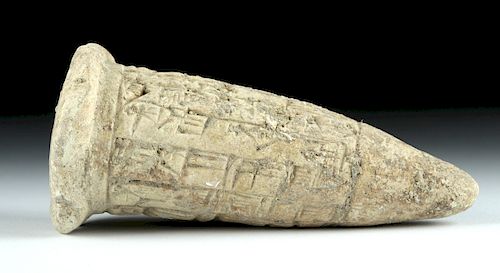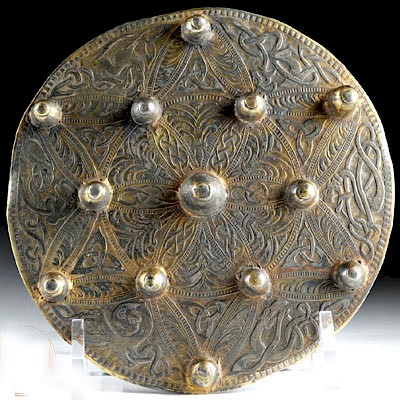Translated Mesopotamian Clay Foundation Cone
Lot 53a
About Seller
Artemis Gallery
686 S Taylor Ave, Ste 106
Louisville, CO 80027
United States
Selling antiquities, ancient and ethnographic art online since 1993, Artemis Gallery specializes in Classical Antiquities (Egyptian, Greek, Roman, Near Eastern), Asian, Pre-Columbian, African / Tribal / Oceanographic art. Our extensive inventory includes pottery, stone, metal, wood, glass and textil...Read more
Estimate:
$1,200 - $1,600
Absentee vs Live bid
Two ways to bid:
- Leave a max absentee bid and the platform will bid on your behalf up to your maximum bid during the live auction.
- Bid live during the auction and your bids will be submitted real-time to the auctioneer.
Bid Increments
| Price | Bid Increment |
|---|---|
| $0 | $25 |
| $300 | $50 |
| $1,000 | $100 |
| $2,000 | $250 |
| $5,000 | $500 |
| $10,000 | $1,000 |
| $20,000 | $2,500 |
| $50,000 | $5,000 |
| $100,000 | $10,000 |
| $200,000 | $20,000 |
About Auction
By Artemis Gallery
Jul 19, 2018
Set Reminder
2018-07-19 10:00:00
2018-07-19 10:00:00
America/New_York
Bidsquare
Bidsquare : Fine Antiquities/Ethnographic Art
https://www.bidsquare.com/auctions/artemis-gallery/fine-antiquities-ethnographic-art-3329
Featuring classical antiquities, ancient and ethnographic art from cultures encompassing the globe, plus fine art. Artemis Gallery info@artemisgallery.com
Featuring classical antiquities, ancient and ethnographic art from cultures encompassing the globe, plus fine art. Artemis Gallery info@artemisgallery.com
- Lot Description
Ancient Near East, Mesopotamia, reign of Gudea of Lagash, ca. 2144 to 2124 BCE. A fine hand-built foundation cone with roughly three-quarters of its conical body wrapped in cuneiform text. The body tapers to a rounded point and has a wide, disc-shaped head on the other end. The thirteen columns of text were created by impressing a sharpened reed or stick into the still-wet clay just before undergoing the kilning process. Clay nails like this are also referred to as dedication pegs or funerary pegs; they were inscribed, baked, and stuck into walls made of mud-brick to mark ownership either by a god or a ruler These dedications sometimes include stories or boasts about the rulers they describe, and are some of our earliest sources of royal written history. Size: 4.75" L x 2.125" W (12.1 cm x 5.4 cm).
This cone was created during the reign of Gudea of Lagash. When translated, it roughly reads, "Gudea, Ensi (ruler) of Lagash, produced resplendently everything appropriate for Ningirsu, Warrior of Enlil, and built and restored his E-ninnu (Ningirsu's temple), the bright Imdugud ("heavy wind") bird."
For a similar example and credit for the translation of this foundation cone, please see the Detroit Institute of Arts, accession number 1983.34: https://www.dia.org/art/collection/object/foundation-cone-gudea-king-lagash-55609
Provenance: private East Coast, USA collection
All items legal to buy/sell under U.S. Statute covering cultural patrimony Code 2600, CHAPTER 14, and are guaranteed to be as described or your money back.
A Certificate of Authenticity will accompany all winning bids.
We ship worldwide and handle all shipping in-house for your convenience.
#135564Surface wear and abrasions commensurate with age as expected, small losses to discoid head, fading to some areas of inscribed text, and roughness across most surfaces. Nice earthen deposits and encrustations throughout.Condition
- Shipping Info
-
All shipping is handled in-house for your convenience. Your invoice from Artemis Gallery will include shipping calculation instructions. If in doubt, please inquire BEFORE bidding for estimated shipping costs for individual items.
-
- Buyer's Premium



 EUR
EUR CAD
CAD AUD
AUD GBP
GBP MXN
MXN HKD
HKD CNY
CNY MYR
MYR SEK
SEK SGD
SGD CHF
CHF THB
THB














